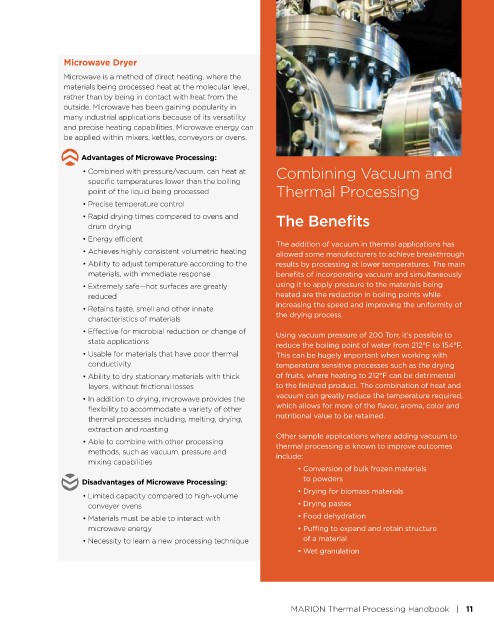Page 2713 - Flipbook_SolidDesignSoutheast2020
P. 2713
Microwave Dryer
Microwave is a method of direct heating, where the
materials being processed heat at the molecular level,
rather than by being in contact with heat from the
outside. Microwave has been gaining popularity in
many industrial applications because of its versatility
and precise heating capabilities. Microwave energy can
be applied within mixers, kettles, conveyors or ovens.
Advantages of Microwave Processing:
• Combined with pressure/vacuum, can heat at Combining Vacuum and
specific temperatures lower than the boiling
point of the liquid being processed Thermal Processing
• Precise temperature control
• Rapid drying times compared to ovens and The Benefits
drum drying
• Energy efficient
The addition of vacuum in thermal applications has
• Achieves highly consistent volumetric heating allowed some manufacturers to achieve breakthrough
• Ability to adjust temperature according to the results by processing at lower temperatures. The main
materials, with immediate response benefits of incorporating vacuum and simultaneously
• Extremely safe—hot surfaces are greatly using it to apply pressure to the materials being
reduced heated are the reduction in boiling points while
increasing the speed and improving the uniformity of
• Retains taste, smell and other innate
characteristics of materials the drying process.
• Effective for microbial reduction or change of Using vacuum pressure of 200 Torr, it’s possible to
state applications reduce the boiling point of water from 212°F to 154°F.
• Usable for materials that have poor thermal This can be hugely important when working with
conductivity temperature sensitive processes such as the drying
• Ability to dry stationary materials with thick of fruits, where heating to 212°F can be detrimental
layers, without frictional losses to the finished product. The combination of heat and
• In addition to drying, microwave provides the vacuum can greatly reduce the temperature required,
flexibility to accommodate a variety of other which allows for more of the flavor, aroma, color and
thermal processes including, melting, drying, nutritional value to be retained.
extraction and roasting
Other sample applications where adding vacuum to
• Able to combine with other processing thermal processing is known to improve outcomes
methods, such as vacuum, pressure and include:
mixing capabilities
• Conversion of bulk frozen materials
Disadvantages of Microwave Processing: to powders
• Drying for biomass materials
• Limited capacity compared to high-volume
conveyer ovens • Drying pastes
• Materials must be able to interact with • Food dehydration
microwave energy • Puffing to expand and retain structure
• Necessity to learn a new processing technique of a material
• Wet granulation
MARION Thermal Processing Handbook | 11

